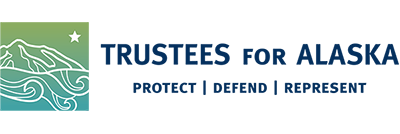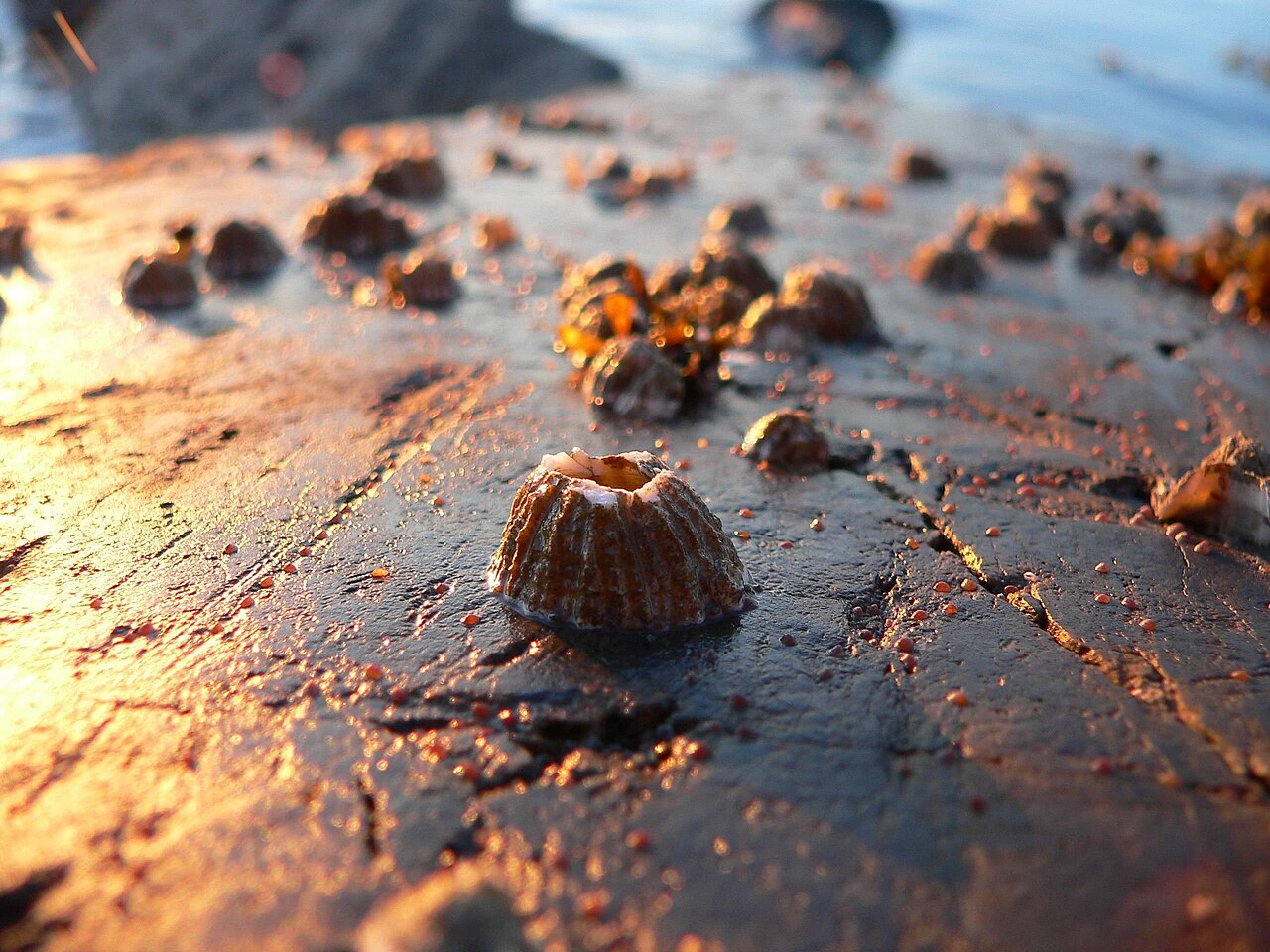
Beings and biomes—an intertidal abundance
By Madison Grosvenor
Twice a day, the ocean pulls away from Alaska’s shorelines, revealing a hidden world teeming with life. Here, barnacles banter with crashing waves, sea stars hunt within tidepools, and meadows of eelgrass sway just beneath the surface. From slick rocks to meandering mudflats, the intertidal zone is anything but still. It’s a living, shifting community.
Life in the splash zone
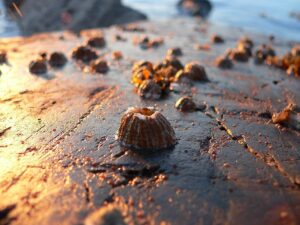
A sunset hitting barnacle-covered rocks at low tide in Glacier Bay National Park. Photo courtesy of National Park Service.
The splash zone, also known as the supralittoral zone, marks the upper boundary of the intertidal habitat and is only occasionally wetted by the highest tides or ocean spray. Despite its infrequent exposure to seawater, this zone supports a specialized group of beings adapted to withstand harsh, fluctuating conditions including air exposure, temperature extremes, and salt spray.
Here, rocks are painted with hardy lichens and splattered with green algae who provide critical food sources for grazing invertebrates, forming the base of the food web. Sea snails like limpets and periwinkles inch along, scraping microscopic algae from the rock surfaces.
Some of the smallest but toughest creatures call this zone home. Barnacles and limpets anchor themselves tightly to the rock, relying on their protective shells to retain moisture and withstand desiccation, or stress due to air exposure to marine life. Shore crabs scavenge on organic debris, darting between hiding places, on careful watch to evade the sea gulls and other shorebirds above.
As you move downward from the splash zone, the rocks grow damper and more alive, hinting at a bustling world just below the spray.
Between worlds
The high tide zone in Alaska’s intertidal regions is a wild and ever-changing place, a kind of coastal crossroads.
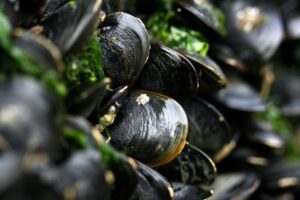
Blue mussels coat the rocks in the high intertidal zone. Photo courtesy of NOAA.
This is a transitional area that experiences regular but brief submersion during the highest tides. Positioned just below the splash zone and above the mid-intertidal zone, it functions as a buffer where marine and terrestrial influences intersect. This zone is alternately exposed to air and submerged in seawater, creating a rhythm of wet and dry cycles that helps shape the ecological dynamics within it.
When the tide returns, it brings fresh oxygen, food particles, and cool water, refreshing the area. It’s also a prime spot for nutrients to move between land and sea, for young marine creatures to grow, and for organic material to be broken down and recycled.
Many filter feeders, like certain species of barnacles and mussels, cluster tightly on rocks where waves can reach them during high tides, taking advantage of the brief underwater periods to feed. Sea stars and anemones edge into this zone from below during especially high tides, while algae such as rockweed cling to surfaces, helping trap moisture and provide shelter.
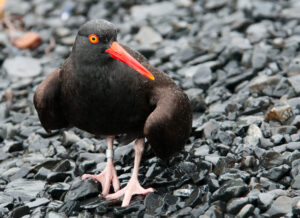
Oystercatcher forages in Kenai Fjords National Park. Photo by Kent Miller/NPS.
Shorebirds like oystercatchers and sandpipers time their feeding around the tides, foraging for exposed invertebrates left behind. These creatures not only endure harsh conditions but rely on the high tide zone as a critical space for feeding, resting, or sheltering in the constantly shifting shores.
The tidal dinner bell
Submerged and exposed twice daily with the ebb and flow of the tides, the mid-intertidal zone experiences more consistent moisture and nutrient availability than the high zone.
This area is often densely packed with seaweeds like kelp, rockweed, and red algae anchored to rocks, creating a shaded, cooler microclimate beneath the waves that hosts an array of microorganisms.
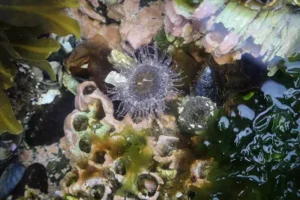
Sea anemones and various invertebrates of Southeast Alaska’s intertidal zones. Photo courtesy of NOAA.
The zone provides an ideal habitat for a variety of filter feeders, such as mussels and sea anemones, which rely on the regular tidal influx to deliver food particles—like plankton, algae, and other nutrients—suspended in the water and washed down from the land. Crabs, like green and helmet crabs, scuttle through seaweed in search of food and shelter, while small tidepool fish, such as sculpins and gunnels, dart between crevices, using the algae for camouflage and protection.
Ecological relationships are common in the mid-intertidal zone. Mussel beds, for instance, offer habitat for a variety of other species while also providing food for powerful predators like sea stars and birds during low tide.
Some animals, like hermit crabs and certain shrimp species, live in mutualistic relationships with anemones, using them as protection from predators while offering mobility for their hosts.
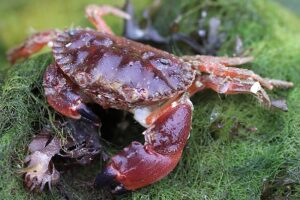
Rock crab scavenges along the rocks and kelp. Photo by Erin McKittrick.
At higher tides, sea otters move in to forage, prying mussels and other invertebrates from the rocks with their paws.
The presence of diverse predator, grazer, and scavenger animals keeps the ecosystem in balance, preventing any one species from dominating. Even migratory birds rely on this zone seasonally, timing their visits to align with the exposure of the rich feeding grounds.
The ebbs and flows of the low zone
The low tide zone is where the ocean truly shows off. Submerged most of the time and only briefly exposed during the lowest tides, this zone hosts a rich ecosystem bursting with life. It’s a haven for delicate species that can’t tolerate long exposure to air, like sea stars, urchins, feather duster worms, and vibrant anemones.
Dominant species include large barnacles, mussels, and a variety of seaweeds, forming the physical structure of the zone. These organisms create a mosaic of surfaces and crevices that host mobile grazers such as chitons, limpets, and the lined shore crab.
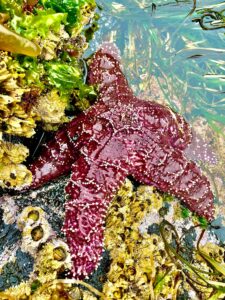
Ochre sea star at St. Lazaria Island. Photo by USFWS.
Predators in this zone help regulate the balance of species. The ochre sea star is a keystone predator that feeds on mussels and barnacles, preventing them from monopolizing space. The leather star and various nudibranchs feed on sponges and hydroids, while small fishes like tidepool sculpins hunt amphipods and larvae. Filter feeders like the plume worm and solitary tunicates rely on incoming tides to bring in suspended food particles.
Because it stays underwater longer, the low intertidal zone supports more biodiversity and delicate ecological relationships than the zones above. Predator-prey interactions thrive here: sea stars hunt bivalves, crabs scavenge and forage, and larger animals like sea otters and seals occasionally forage along their edge.
As the tide ebbs and flows, it dictates movement, feeding, and respiration. This pulsing rhythm drives ecological interactions, forcing species to specialize in timing, location, and tolerance to maintain their foothold in a highly competitive space.
The forests beneath the surface
Despite the intertidal zone being full of organisms that have adapted to endure turbulent, changing conditions, it remains an incredibly fragile biome. Coastal erosion, storm-fueled battering waves, and long, sun-exposed days constantly test the limits of its residents. Just below this turbulent strip, the subtidal zone begins—stepping in as a quiet protector of intertidal beings and habitat.
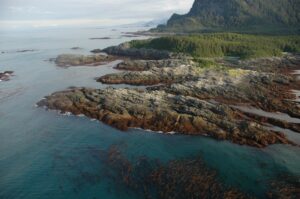
Kelp forest just off the shoreline. Photo by Mandy Lindeberg, NOAA.
Kelp forests in Alaska are incredible underwater jungles, providing habitat for fish, otters, seals, and sea lions and so much more.
The dense blades of giant kelp dampen wave energy before it reaches the shore, reducing the physical impact on intertidal organisms and helping to prevent and mitigate coastal erosion.
The towering canopy also stabilizes sediments and influences local water chemistry by producing oxygen and absorbing nutrients. In doing so, kelp forests support overall shoreline resilience and contribute to both the productivity and protection of the communities living at the margins between sea and land.
The kelp canopy is often teeming with young fish, crabs, vibrant nudibranchs, and even the occasional octopus sliding through the rocks on the hunt.
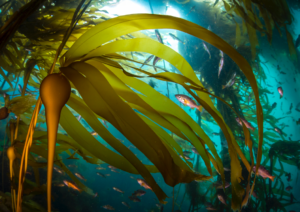
Alaska’s kelp forests are a haven for juvenile fish and countless other species. Photo by Tavish Campbell.
Towering algae also function as natural carbon sinks, absorbing large amounts of carbon dioxide through photosynthesis and helping to buffer the effects of climate change. By drawing carbon from the atmosphere and storing it in tissue and the ocean floor, kelp forests play a key role in global carbon cycling.
Their importance doesn’t stop there. They also form the foundation of a rich marine food web, providing food, shelter, and critical nursery grounds for countless species. From tiny invertebrates to fish, sea otters, and even seabirds that hunt in the nearshore waters, these forests sustain a variety of beings above and below the surface.
Though hidden from sight, the subtidal zone and its forests are a quiet but essential ally to the intertidal world, offering support far beyond the tide’s reach.
The eelgrass bridge
Though kelp forests dominate the rocky subtidal zones, Alaska’s softer, sheltered coastal areas are shaped by another crucial marine plant: eelgrass. Where wave energy lessens and sediments settle, eelgrass beds take root, bridging the subtidal and intertidal zones with magical underwater meadows.
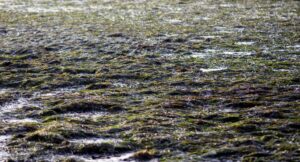
Eelgrass beds at low tide in Izembek National Wildlife Refuge.
These habitats may lack the towering height of kelp forests, but their ecological importance is just as significant.
In Alaska’s intertidal zones, eelgrass forms lush, green meadows in protected bays, estuaries, and shallow shorelines. These flowering marine plants anchor themselves in sandy or muddy substrates, thriving in the lower intertidal and shallow subtidal zones where they remain mostly submerged.
Unlike algae, eelgrass is a true plant, complete with roots, stems, and the incredible ability to photosynthesize underwater. Its dense beds provide essential habitat for a wide array of species, including juvenile fish, crabs, sea snails, and filter feeders, while also offering food for migratory waterfowl and invertebrates.
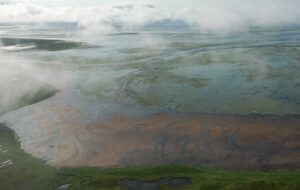
Eelgrass in Izembek Lagoon. Photo by Kristine Sowl, USFWS.
One of the most ecologically and culturally significant eelgrass habitats in Alaska is found in Izembek National Wildlife Refuge, located at the tip of the Alaska Peninsula. Izembek Lagoon contains one of the largest and most pristine eelgrass beds in the Northern Hemisphere, supporting over 90 percent of the world’s population of Pacific black brant during their migrations.
These birds depend almost entirely on eelgrass for food during their stopovers.
The lagoon also supports other migratory birds, marine mammals, and fish species that rely on eelgrass meadows for shelter and sustenance. Beyond its role as a habitat, eelgrass contributes to the health of Alaska’s intertidal zones by stabilizing sediments, improving water clarity, and cycling nutrients. Its root systems help hold soft substrates in place, reducing erosion, while the blades slow water flow and trap particles.
In a region where coastal environments are highly vulnerable to both natural forces and human activity, eelgrass beds serve as vital ecological infrastructure.
A story of interdependence
Twice a day, the tide transforms Alaska’s intertidal zones from vibrant underwater neighborhoods into exposed, sunlit landscapes, and back again. This constant motion doesn’t just shape the coastline; it structures the entire web of life within it.
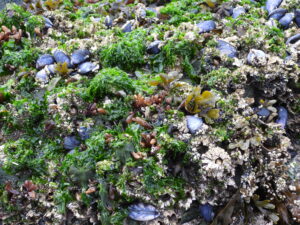
Communities of filter-feeders and invertebrates thrive in the mid-intertidal zone. Photo by Drew Murray.
Every creature, from tidepool sculpins to migrating brant, is tuned to this rhythm. Some depend on the tide to bring food, others to escape predators or find shelter.
The splash zone’s lichens, the mussel beds of the mid-intertidal, the migratory birds of the eelgrass meadows, and the slow-moving sea stars of the low tide zone are all connected through this shared pulse. Even the towering kelp forests offshore, and the quiet eelgrass meadows in sheltered bays serve as buffers and nurseries, supporting the intertidal zone both physically and biologically.
Alaska’s intertidal area is not just a place of extremes. It’s a story of precise timing, constant adaptation, and deep ecological interdependence.
Alaska’s intertidal zones face growing threats from climate change, coastal industrialization, and increased human activity. Warming ocean temperatures, sea level rise, and ocean acidification can alter species distributions, disrupt food webs, and weaken the resilience of these delicate systems.
Oil spills and marine pollution pose direct dangers to filter feeders and shoreline habitats, while expanding infrastructure can damage eelgrass beds and disrupt natural tidal flows.
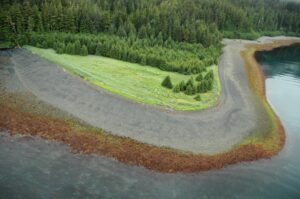
The layers of the intertidal zone. Photo by Mandy Lindeberg, NOAA.
Protecting these zones is crucial—not only because they support an incredible diversity of life, but because they serve as natural buffers against erosion, nurseries for fish, and key links in global migratory pathways. The importance of these zones stretch far beyond the rocky shores. Safeguarding them ensures the survival of both local ecosystems and the coastal communities that depend on them.
To understand this stretch of shoreline means understanding it as a community built on the movement of water and the intricate ties between its residents.
Just as every organism in the intertidal zone relies on the rhythm of the tides and the support of its neighbors, we too are part of this greater cycle. Our choices and behaviors ripple outward, shaping the future of these vital coastal ecosystems.
Protecting these zones means supporting science-based conservation, limiting pollution, respecting tidepool habitats, and advocating for policies that safeguard shoreline and marine environments.
By recognizing our place in this incredible network of interdependence, we can help ensure that Alaska’s intertidal zones remain full of life.
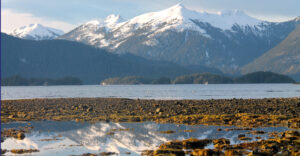
View of low tide from the beach in Sitka National Historical Park. Photo courtesy of NPS.
This is the fifth in our “Beings and biomes” series. You can find previous articles below:


